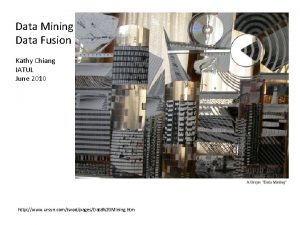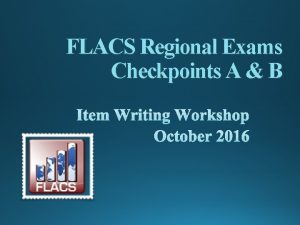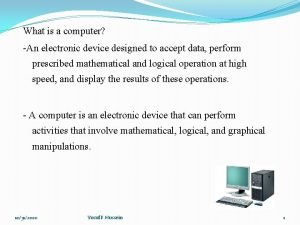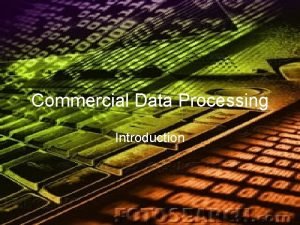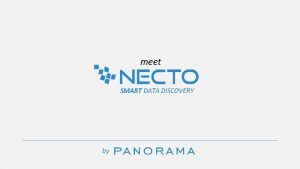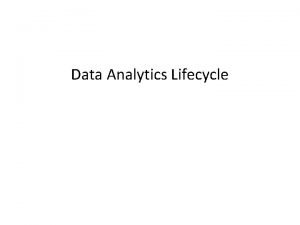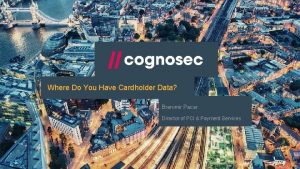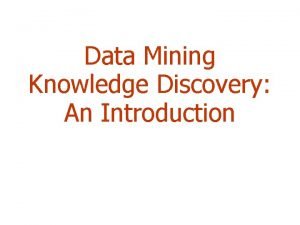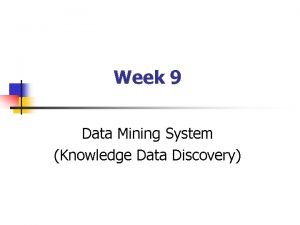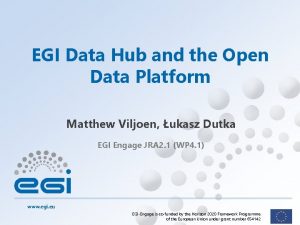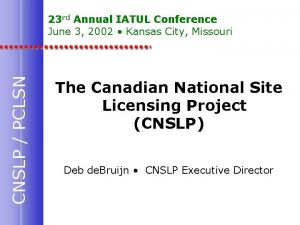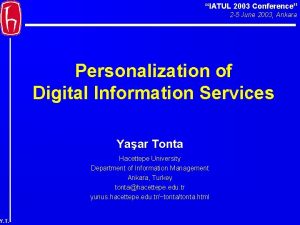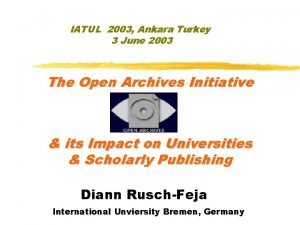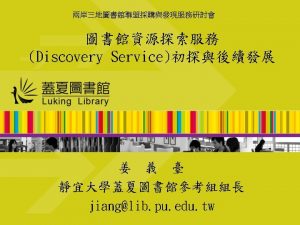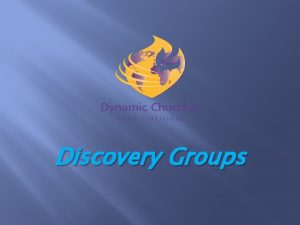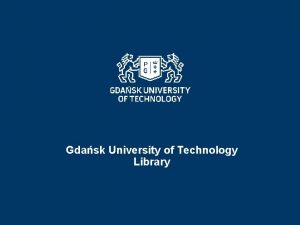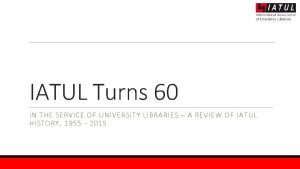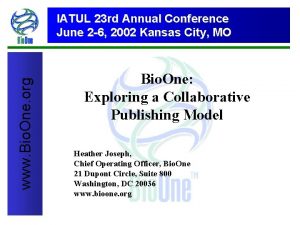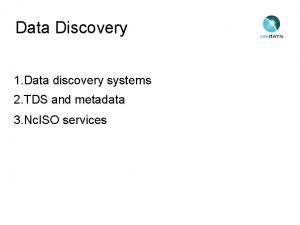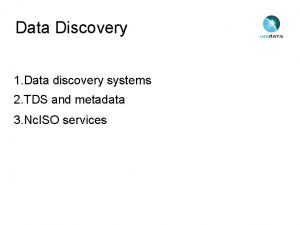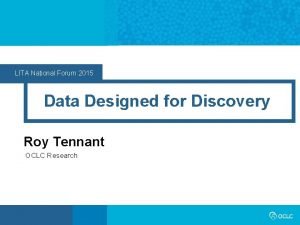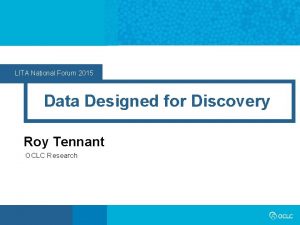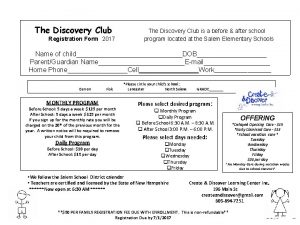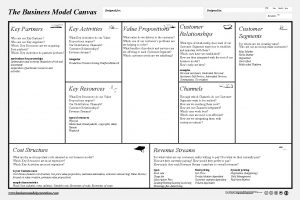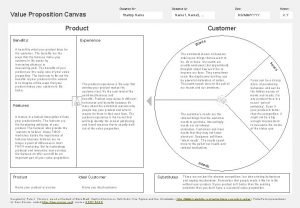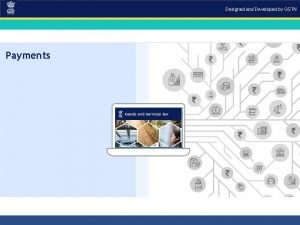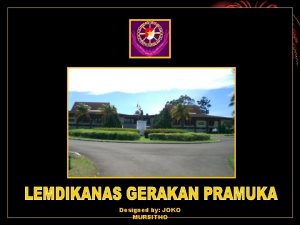IATUL 20 June 2017 Data Designed for Discovery





















































- Slides: 53

IATUL • 20 June 2017 Data Designed for Discovery Roy Tennant Senior Program Officer, OCLC Research


The world’s largest and most consulted bibliographic database • 2. 5 Billion holdings • 400 Million bibliographic records • 10 Million Italian records • 57% non-English Where librarians and library patrons search

A few introductory remarks • This is the Research view of linked data • We (OCLC) have experiments and prototypes, but no products or production services (yet) • We (OCLC Research) have been working with linked data for as long as anyone in the library world • Our (OCLC Research) playground is the entirety of World. Cat ( million records) and a parallel computing cluster • Stay tuned for more information on production services

WHY LINKED DATA?

What we have to work with

What we have to work with • A collection of text strings… • Taken from the piece itself… • Sometimes “enhanced” with inferred parentheticals (e. g. , [1975] )… • Or additional statements not on the piece (e. g. , subject headings) • Punctuation, which may or may not be present, is used (inconsistently) for structure • Mostly uncontrolled and only loosely connected to anything else • Designed for description rather than discovery

THE PROBLEM

Actually, A Number of Problems • Identification Problems (two illustrated next): – The Title Problem – The Names Problem • Quality Problems (one illustrated next): – The Legacy Problem (strings are not controlled terms; often, they cannot be turned into them) • Linkage Problems (just two examples): – The Web Problem (records aren’t enough, you need links) – The Language Problem (showing the right translation for a given user)

The Title Problem

The Name Problem

Data Quality Problems

THE SOLUTION

d e k n ” i L ies First, define = t i ALL THE S t n G THINGS e N “ I a H t T a D

Quick Definitions entity /ˈɛntɪti/ noun a thing with distinct and independent existence. relationship /rɪˈleɪʃ(ə)nʃɪp/ noun the way in which two or more people or things are connected

…then establish relationships with other entities Albert Einstein Person s a n author w ” o s n k le p o i s Tr about l A “ Relativity: The Special and General Theory Work Physics Concept

…with actionable links from authoritative data hubs https: //www. wikidata. org/wiki/Q 937 and http: //viaf. org/viaf/75121530 Wikidata and VIAF author http: //experiment. worldcat. org/entity/work/data/369081611 World. Cat Works about http: //id. loc. gov/authorities/subjects/sh 85101653. html Library of Congress Subject Headings

A REAL WORLD EXAMPLE

From Records to Entities: Works





OCLC Production Services Linked Data LCSH Entities VIAF Internal OCLC Research Resources FAST enhanced World. Cat GMGPC External OCLC Research Systems WORKS GTT Fiction. Finder Kindred Works Me. SH LCTGM Identities Classify GSAFD Cookbook Finder DDC

OCLC’s linked data resources World. Cat Works: 5 billion RDF triples ISNI: 10 -50 million triples VIAF: 2 billion triples World. Catalog: 15 billion triples FAST: 23 million triples

VIAF aggregates identifiers

Wikidata disseminates identifiers

OCLC’S 2015 INTERNATIONAL LINKED DATA SURVEY SOURCE: KAREN SMITH-YOSHIMURA

2015 responding institutions by type 7% 4% 6% Academic library 31% 8% National library Network 10% Government 14% 20% Scholarly Public Library Museum Other 71 institutions total

What is published as linked data Other Ontologies/vocabularies Geographic data Encoded archival descriptions Digital collections Descriptive metadata Datasets Data about musuem objects Bibliographic data Authority files 0 10 20 30 40 50 60

2015 linked data sources most consumed VIAF (Virtual International Authority File) DBpedia Geo. Names id. loc. gov Resources we convert to linked data ourselves Getty's AAT FAST (Faceted Application of Subject Terminology) World. Cat. org data. bnf. fr Deutsche National Bib Linked Data Service 2015 41 36 35 35 17 16 15 15 12 12

SOLVING PROBLEMS & MOVING TOWARD A LINKED DATA FUTURE

Improving the Discovery Experience p u k c o M



Exploring Ways to Use Linked Data


g n i v l o S ! m e l b o r P e l t i T e th

Offering the right translation Title: 西遊記 Language: Chinese Author: 吳承恩 Created: 1592 Has. Translation: Title: Language: Translator: Date: Is. Translation. Of: Journey to the West English Anthony C. Yu 1977 Title: Language: Translator: Date: Is. Translation. Of: Journey to the West English W. J. F. Jenner 1982 -1984 Title: Language: Translator: Date: Is. Translation. Of: Ta y du ky bi nh kha o Vietnamese Phan Qua n 1980 Title: Language: Translator: Date: Is. Translation. Of: Pilgerfahrt German Georgette Boner 1983 西遊記 Japanese 中野美代子 1986

Offering the right translation m e l b o r P n o i t a l s n a r T e h t g n i v l o S Title: 西遊記 Language: Chinese Author: 吳承恩 Created: 1592 Has. Translation: Title: Language: Translator: Date: Is. Translation. Of: Journey to the West English Anthony C. Yu 1977 Title: Language: Translator: Date: Is. Translation. Of: Journey to the West English W. J. F. Jenner 1982 -1984 Title: Language: Translator: Date: Is. Translation. Of: Ta y du ky bi nh kha o Vietnamese Phan Qua n 1980 Title: Language: Translator: Date: Is. Translation. Of: Pilgerfahrt German Georgette Boner 1983 西遊記 Japanese 中野美代子 1986

Bringing Authority Control to the Web g n i v l o S e th ! m e l b o r P e m a N

Prototyping New Services • Person Lookup Service – An experimental service for looking up OCLC Person Entities • Scenario: – A library wants to disambiguate a name – It sends the name text string to our API – We check all of our aggregated authority files and send back the best match(es) – Each response comes with one or more URIs (e. g. , to LCNAF, Wikidata, ISNI, etc. ) – The library inserts this data into their record, turning a text string into an actionable link on the web

In Summary: Why Linked Data? A better user experience Greater Web visibility Develop better models of resources not well served by current standards Replicate existing library functions more cheaply and efficiently Improve data integration Improve internal data management

EASING THE TRANSITION

Collaborating on BIBFRAME • Working with the Library of Congress and others to finalize the BIBFRAME standard • Beginning to explore what working with it at scale will mean

Working With the Web • Modeling bibliographic data using Schema. org • Collaborating on expanding the Schema. org with additional bibliographic elements at bib. schema. org • Syndicating World. Cat data to search engines using Schema. org markup

Learning About Changing Workflows Photo by https: //www. flickr. com/photos/sanjoselibrary/ - CC BY-SA 2. 0


Making MARC “Linked Data Ready” Least machine-processable If you must use free text: • Use established conventions • Use standardized terms Algorithmically recoverable • Use the most specific fields appropriate for a descriptive task • Minimize the use of 500 fields • Obey field semantics • Avoid redundancy Most machine-processable • • Use uniform titles Use added entries with role codes (7 xx and $4) Use 041 for translations, including intermediate translations Use indicators to refine the meaning

Working With the PCC To Make MARC LD Ready ‘Work’ Task Force Analyze the ‘Work’ definitions referenced in library linked data. • How are they similar or different? • How do they relate to the classic FRBR definition? • What are the use cases for ‘Work? ’ How should Work URIs be represented in MARC records? ‘URI’ Task Force • What are the best practices for adding URIs to MARC records to ease the conversion to linked data? • How will cataloging or resource description workflows be affected?

Summary Remarks • We are in a major transition that will take YEARS to navigate • We don’t know yet exactly what the future holds… • . . . but we know that it will be more linked and machine actionable (not just readable) than ever before • And that’s a Good Thing

For More Information

IATUL • 20 June 2017 Thank you! Roy Tennant @rtennantr@oclc. org facebook. com/roytennant SM Together we make breakthroughs possible. © 2017 OCLC. This work is licensed under a Creative Commons Attribution 4. 0 International License. Suggested attribution: “This work uses content from “Data Designed for Discovery” © OCLC, used under a Creative Commons Attribution 4. 0 International License: http: //creativecommons. org/licenses/by/4. 0/. ”
 Iatul
Iatul Flacs checkpoint b spanish exam june 2017 answers
Flacs checkpoint b spanish exam june 2017 answers A programmable electronic device designed to accept data
A programmable electronic device designed to accept data Commercial data
Commercial data Necto
Necto Discovery phase in data analytics
Discovery phase in data analytics Cardholder data discovery
Cardholder data discovery Introduction to data mining and knowledge discovery
Introduction to data mining and knowledge discovery Knowledge data discovery
Knowledge data discovery Data discovery
Data discovery Data discovery
Data discovery Formuö
Formuö Typiska novell drag
Typiska novell drag Nationell inriktning för artificiell intelligens
Nationell inriktning för artificiell intelligens Returpilarna
Returpilarna Varför kallas perioden 1918-1939 för mellankrigstiden?
Varför kallas perioden 1918-1939 för mellankrigstiden? En lathund för arbete med kontinuitetshantering
En lathund för arbete med kontinuitetshantering Underlag för särskild löneskatt på pensionskostnader
Underlag för särskild löneskatt på pensionskostnader Tidbok
Tidbok Anatomi organ reproduksi
Anatomi organ reproduksi Densitet vatten
Densitet vatten Datorkunskap för nybörjare
Datorkunskap för nybörjare Stig kerman
Stig kerman Debattartikel mall
Debattartikel mall Delegerande ledarstil
Delegerande ledarstil Nyckelkompetenser för livslångt lärande
Nyckelkompetenser för livslångt lärande Påbyggnader för flakfordon
Påbyggnader för flakfordon Arkimedes princip formel
Arkimedes princip formel Svenskt ramverk för digital samverkan
Svenskt ramverk för digital samverkan Lyckans minut erik lindorm analys
Lyckans minut erik lindorm analys Presentera för publik crossboss
Presentera för publik crossboss Jiddisch
Jiddisch Bat mitza
Bat mitza Klassificeringsstruktur för kommunala verksamheter
Klassificeringsstruktur för kommunala verksamheter Epiteltyper
Epiteltyper Claes martinsson
Claes martinsson Centrum för kunskap och säkerhet
Centrum för kunskap och säkerhet Verifikationsplan
Verifikationsplan Mat för idrottare
Mat för idrottare Verktyg för automatisering av utbetalningar
Verktyg för automatisering av utbetalningar Rutin för avvikelsehantering
Rutin för avvikelsehantering Smärtskolan kunskap för livet
Smärtskolan kunskap för livet Ministerstyre för och nackdelar
Ministerstyre för och nackdelar Tack för att ni har lyssnat
Tack för att ni har lyssnat Referat mall
Referat mall Redogör för vad psykologi är
Redogör för vad psykologi är Stål för stötfångarsystem
Stål för stötfångarsystem Atmosfr
Atmosfr Borra hål för knoppar
Borra hål för knoppar Orubbliga rättigheter
Orubbliga rättigheter Variansen formel
Variansen formel Tack för att ni har lyssnat
Tack för att ni har lyssnat Rita perspektiv
Rita perspektiv Informationskartläggning
Informationskartläggning
